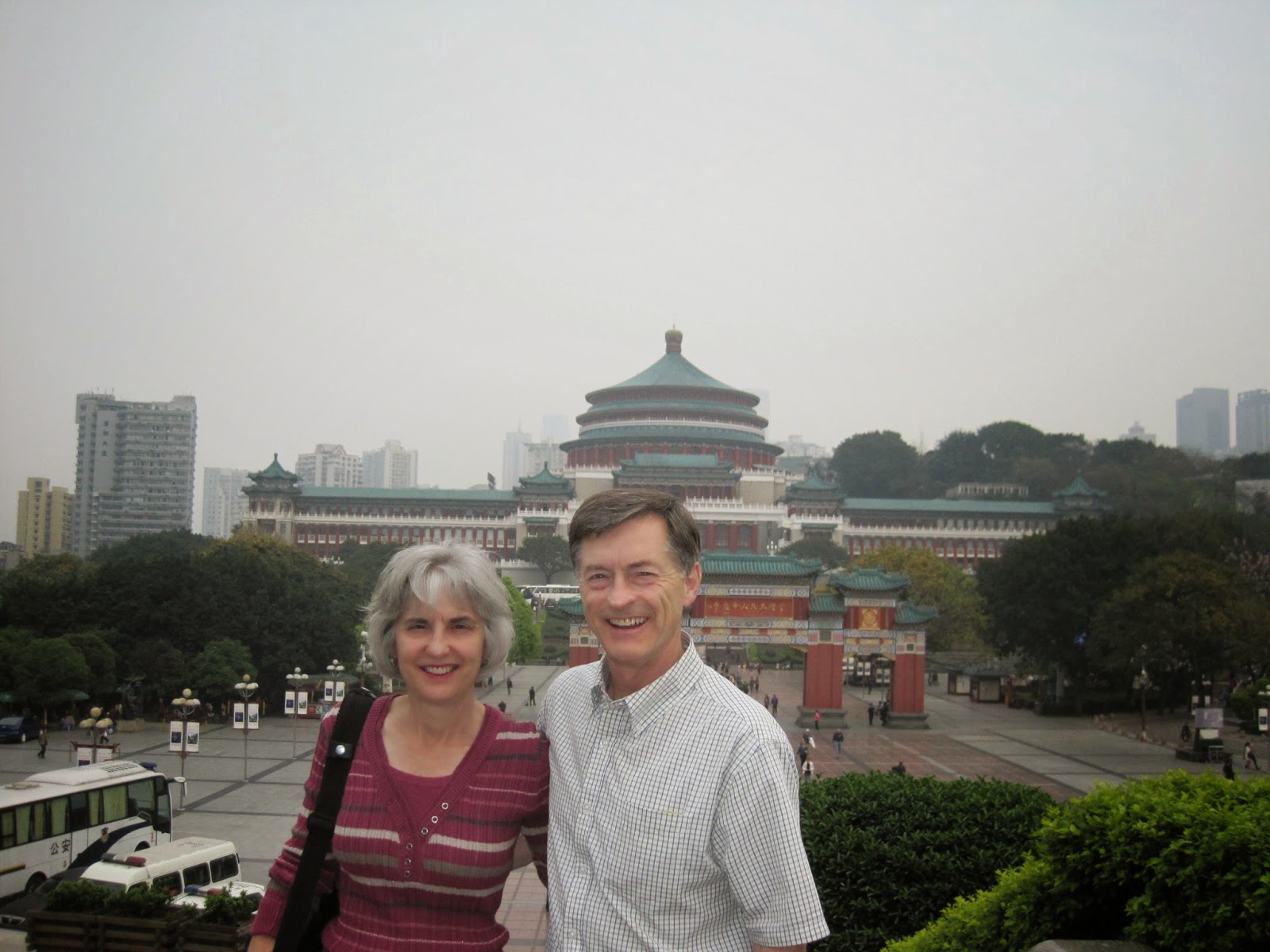We flew to Chongqing and spent the afternoon exploring various historical sites and learning about this unique modern metro area of 34 million residents. Our guide told us that Chongqing is known for: hot pot and pretty women!
This is a Provincial Congress building built in 1954 in Chongqing
At one end of the square is the Provincial Congress building and at the other end where we are standing is the museum.
This is a museum about the Three Gorges area which was dammed to provide water and electricity to the region, as well as Shanghai, etc. The building actually looks like a dam from the outside.Part of our tour of Chongqing was this museum dedicated to the "Flying Tigers," a US unofficially sanctioned air combat group that helped the Chinese fight the Japanese during WWII. The name came when the group won a battle with unfavorable odds and a journalist said they "flew like tiger". The Chinese still talk about this and are appreciative of the support and training they received from this elite volunteer group.
The museum is located on a hill above the city. Very narrow streets.
We boarded the "5 Star" Presidential #8 at about 8:30 p.m. We were scheduled to sail at 10pm, but since everyone was on board (all 350 of us, as passengers and crew), we left early.
This is a night shot of Chongqing. Cruise ships line the shoreline.
This map shows the cruise route. Chongqing to Yichang. There are three major gorges between those cities. They reminded us of the Columbia Gorge in Oregon.
This was our boat, the Presidential #8. We actually walked on those "rafts" to get to the boat!
Dining room
Stan relaxing in our bedroom on the cruise
We sailed through the night to a location some 200 kilometers down river. Some time during the night it started to rain. The forecast led us to believe that there was, at most, a 60% chance of rain and only during one day of our voyage. That turned out to be wrong. Most of the trip the skies were gray, the fog was in and the precipitation high. Since we are Oregonians, the rain is only a minor nuisance. We still went on 4 different shore excursions. I can't tell you the number of pagodas we have toured in while in this country. We added a few more to our list. One was quite interesting in that it was built into a rock wall. No nails were used in its construction and it wasn't actually attached to the rock wall. It was held in place by the way the timbers were angled in.
Nancy just loves the rain
There are three bridges to represent the first judgment linking the underground. Troubled water comes from the idea that if you are evil you can be knocked into the water.
Walking hand in hand over this middle bridge is for persons who have been "good" in their mortality and they are supposed to have love forever.
You guessed it, the 5 bats represent happiness
These folks guard the way to the Buddhist Temple. This one snorts and is crushing a demon under his foot!
This is a Chinese character meaning happiness. On the right is a line which means roof, a square for a person and a field for crops. Essentially if you have a roof over your head and something to eat, you are happy!!
BYU teacher, David Cox trying to move a 400 lb. ball of lead and iron to the top of the ball in the center. This is a test for a future husband. If he is successful he will have the strength to be a farmer and be a faithful spouse, having no concubines!
David was not successful, but this local farmer was. He makes more money from the tourists by demonstrating his strength so he gave up farming!
On the ship there was a demonstration of painting snuff bottles. The artist uses a small brush with a slight hook that is inserted into the bottle. The design is painted in "negative" so the proper picture will show on the outside. We were told that only 100 artists in China still practice this craft.
This suspension bridge led to a pagoda. The bridge was built in the last few years, but was not yet "finished". We were grateful to cross successfully!
This sign has 4 Chinese characters that are combined and mean "only kindness brings peace".
This emperor was the King in Chinese heaven and with his advisors. His wife, the "queen" of heaven was off to the side.
These interesting people are characters sent to earth to execute judgment based on orders from Yama,
Original Yama, represents a god of death and judgment, in a Buddhist temple that was built in the 1600's and not destroyed in the Cultural Revolution. The red color means warm and represents heaven. Another section of the temple was blue for hell since that color means cold!
Our river cruise "guide", Alice, who was responsible for the daily activities onboard the ship and organized us when we went ashore for excursions. She was being the mistress of ceremonies for a staff talent show.




























2 comments:
Dear Paces,
Found your blog and that you are from Hillsboro! I live in Medford;my father-in-law raises apples and hazelnuts outside of Forest Grove.
I will be one of the single teachers at Qingdao University in the Fall.
LOVE your blog! thanks, Meghan
Your post is really good providing good informations about Yangtze River Cruise
.. I liked it and enjoyed reading it.
Post a Comment